2019
100 copies
Signed and numbered
100 copies
Signed and numbered
Slipcase:
41,5×30×7 cm
16.3×11.8×2.7 in.
41,5×30×7 cm
16.3×11.8×2.7 in.


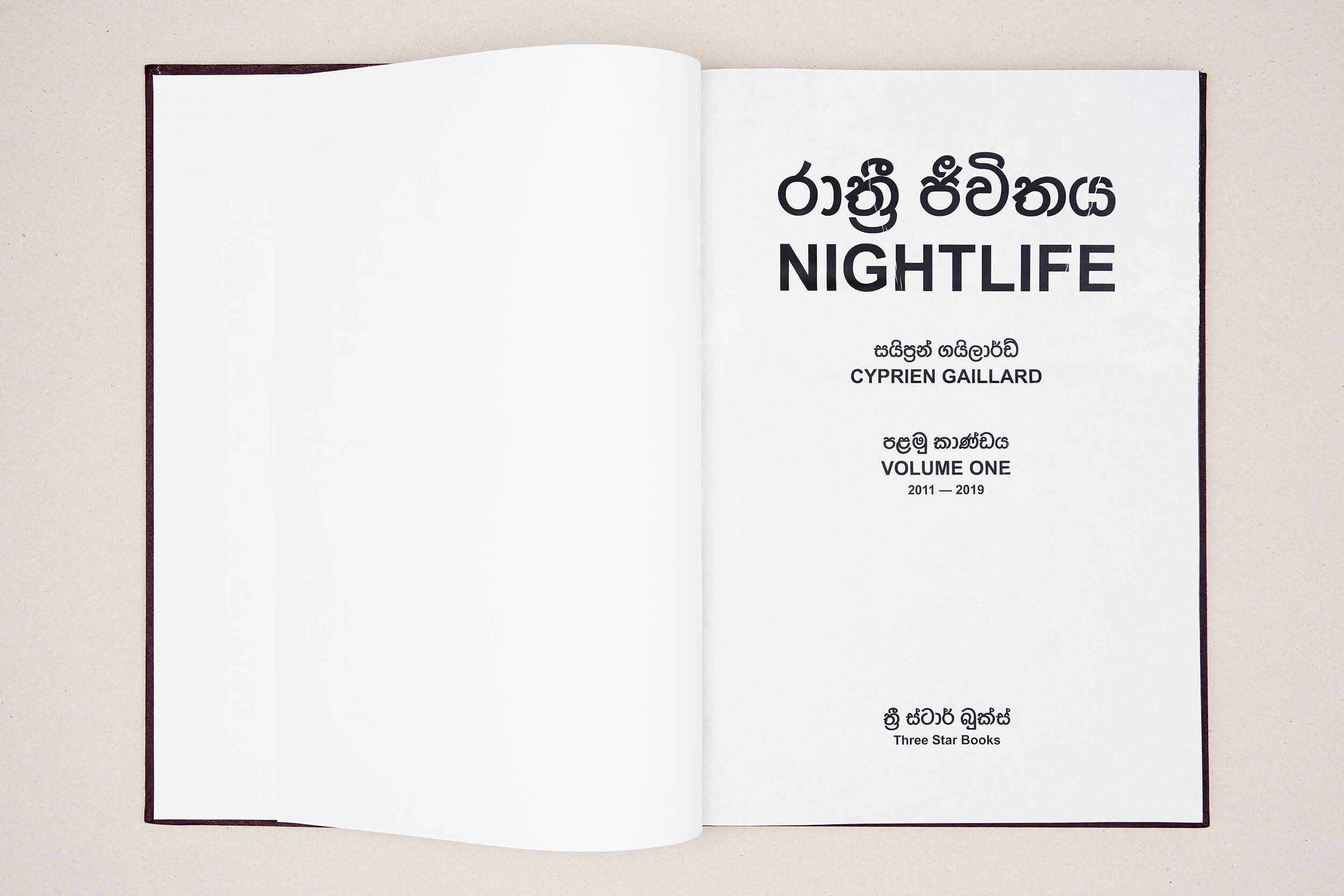







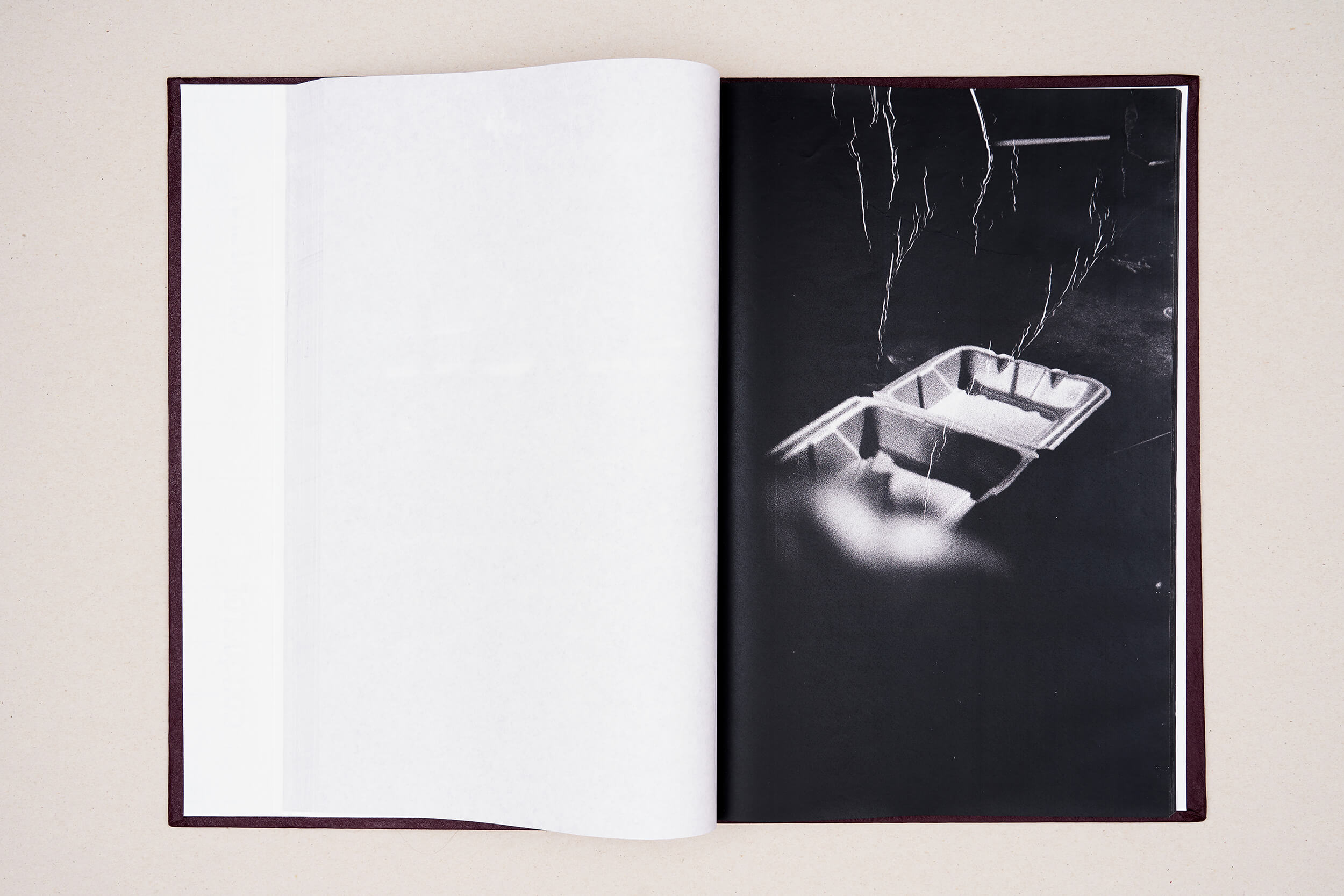



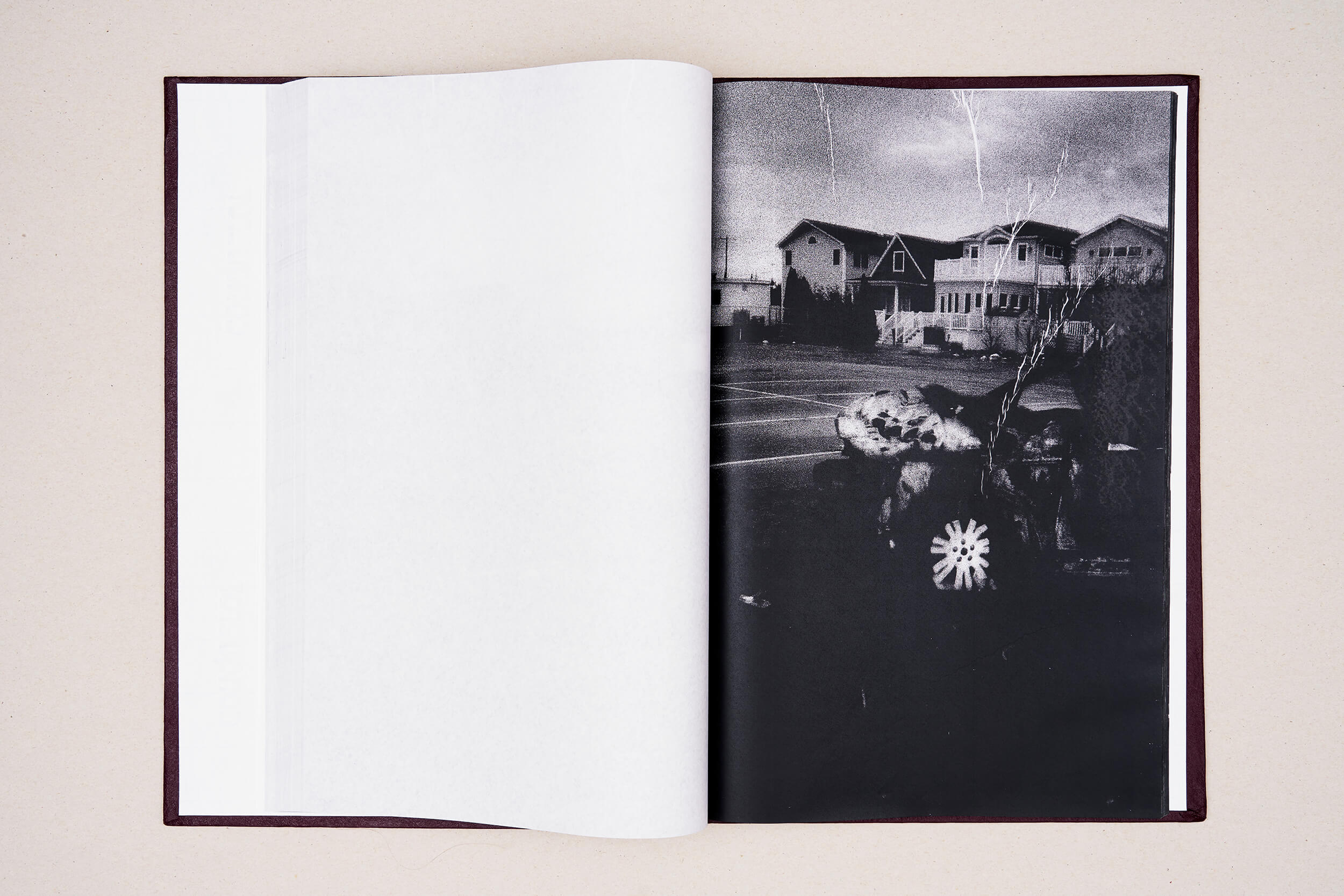





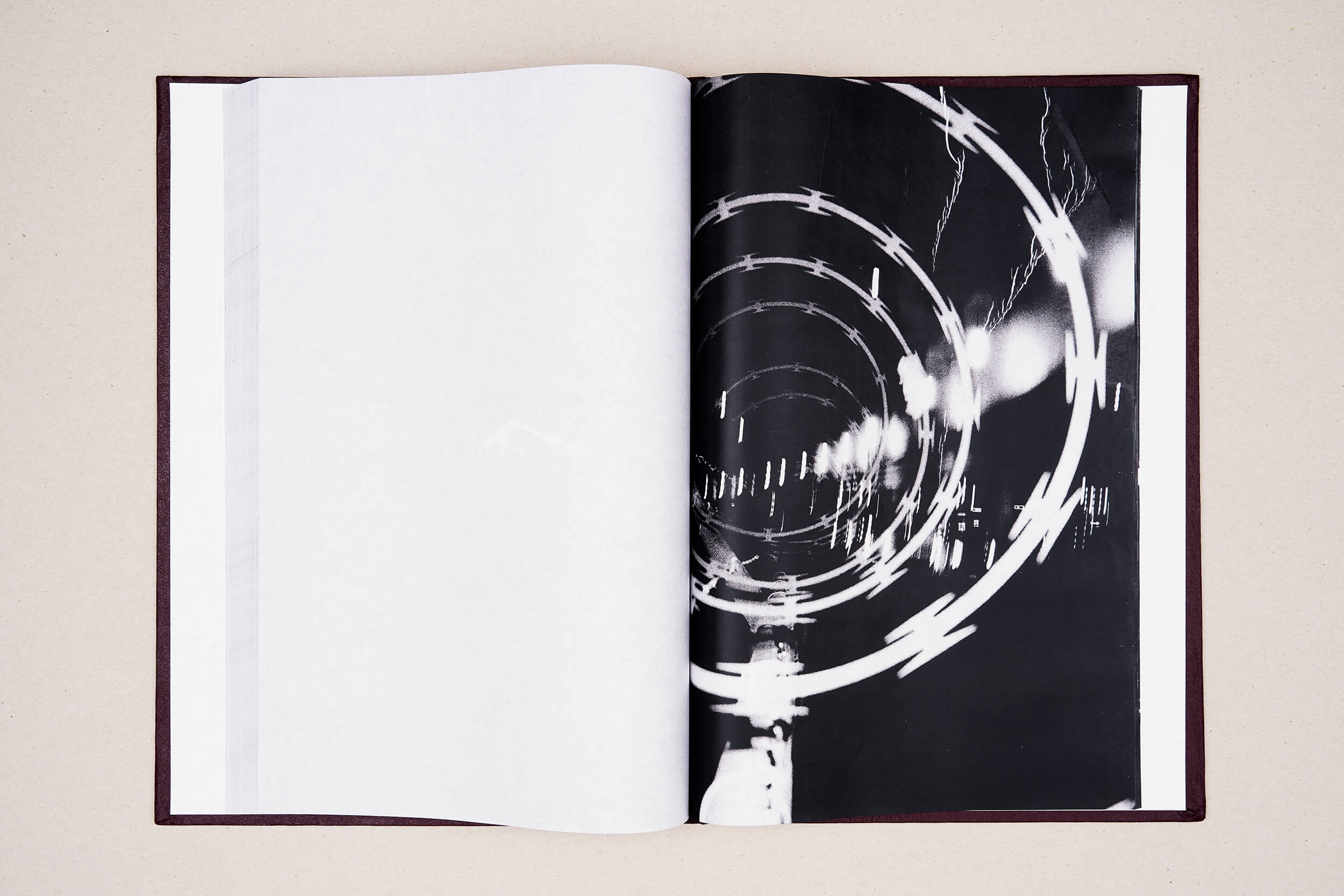




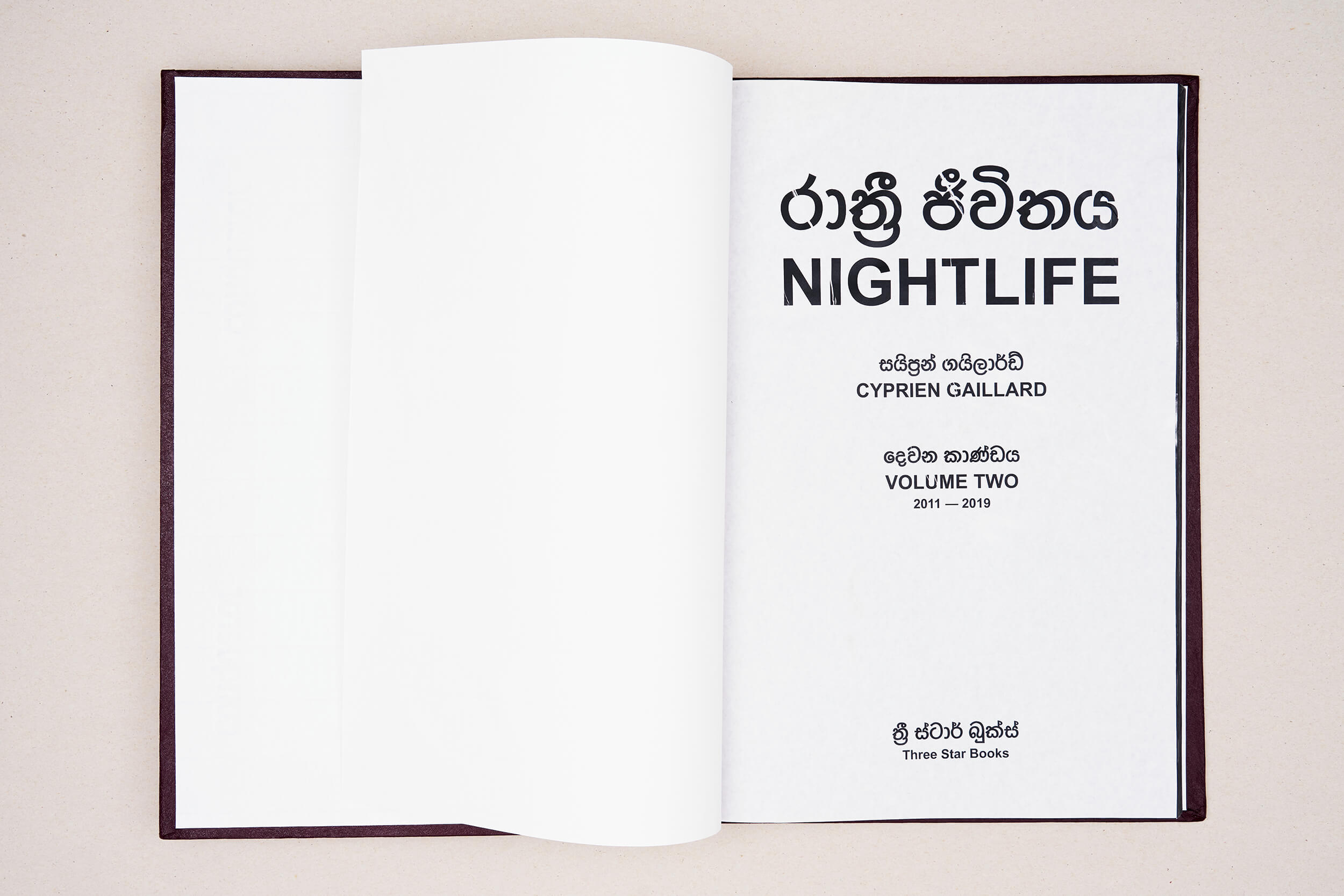





















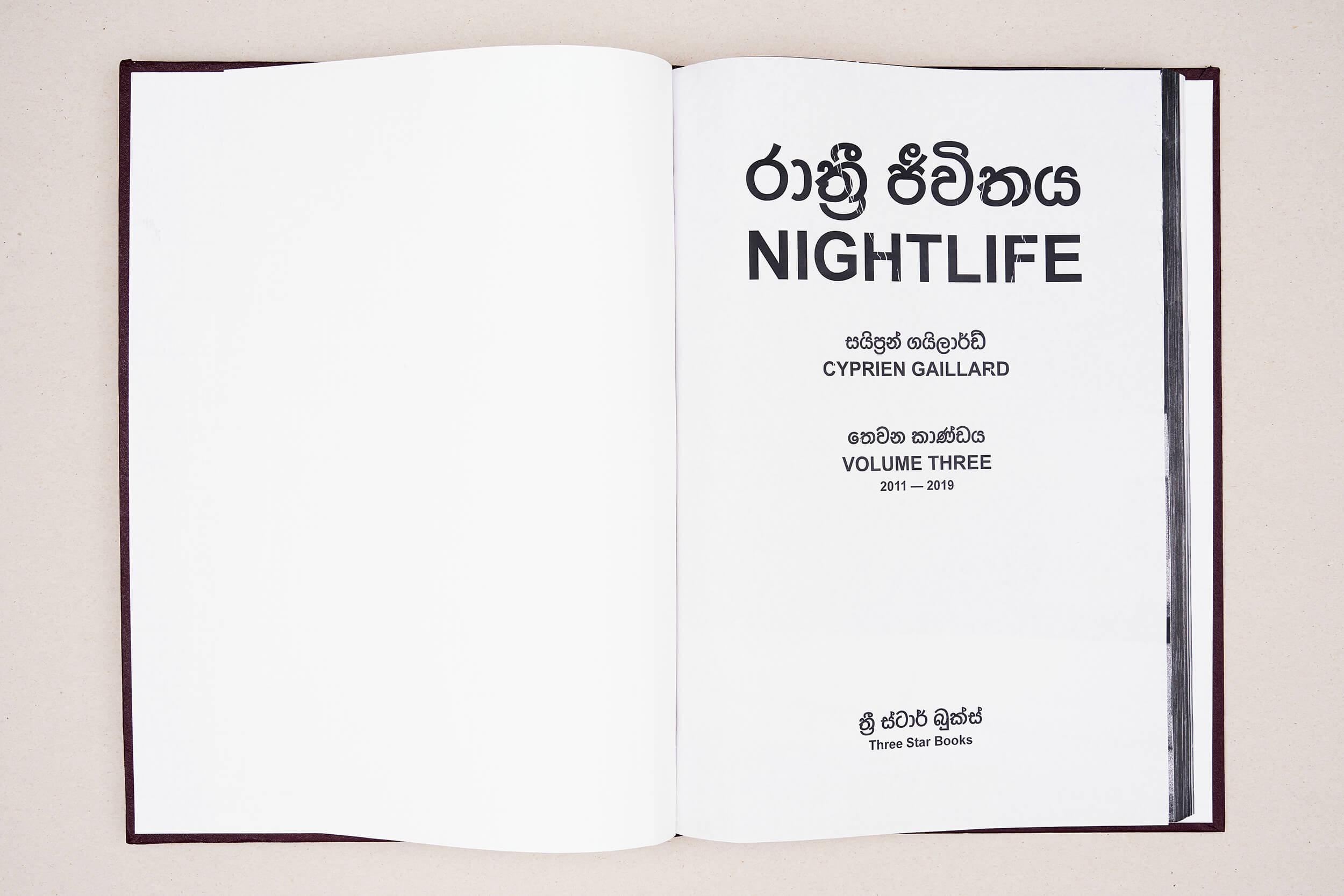








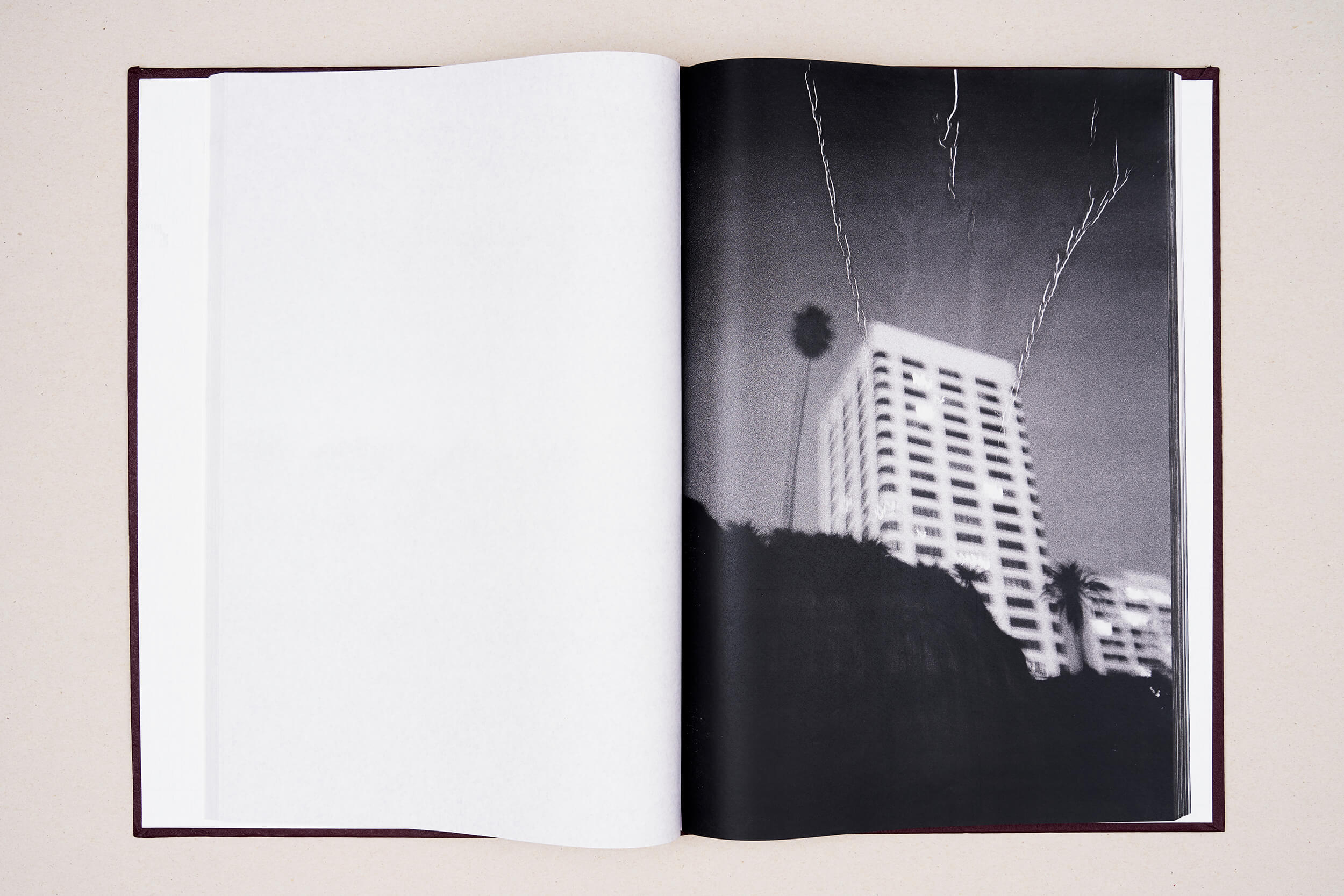








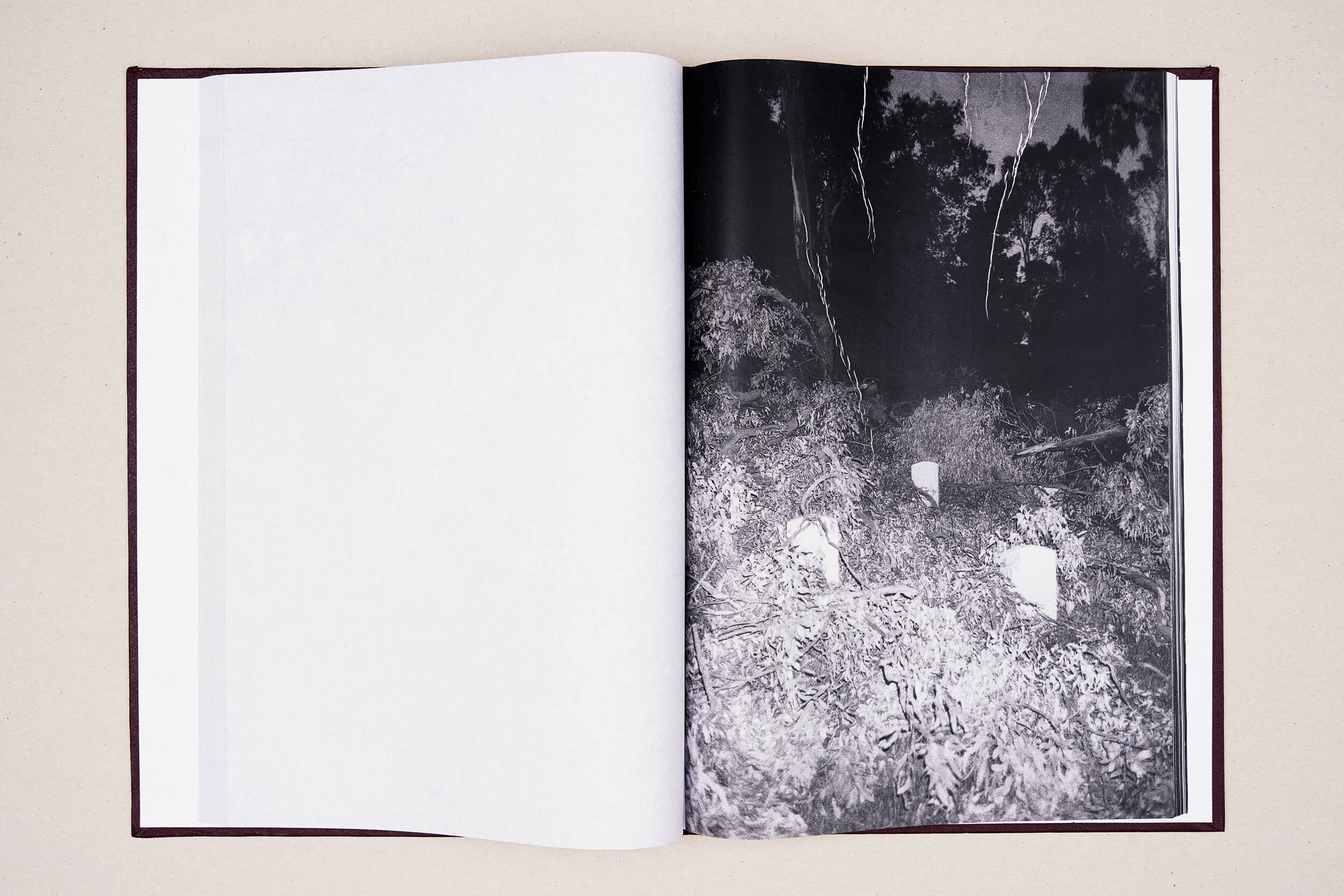
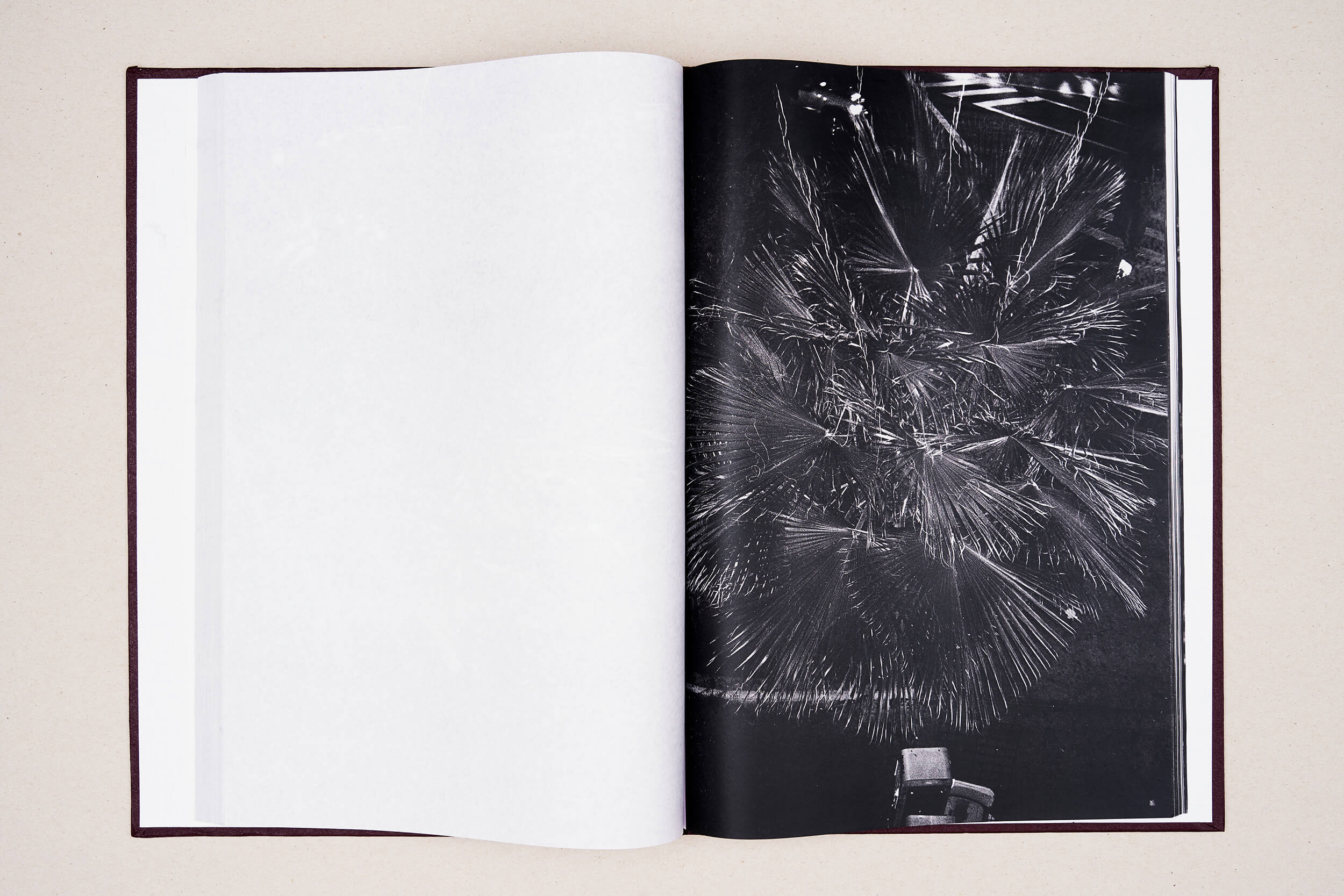


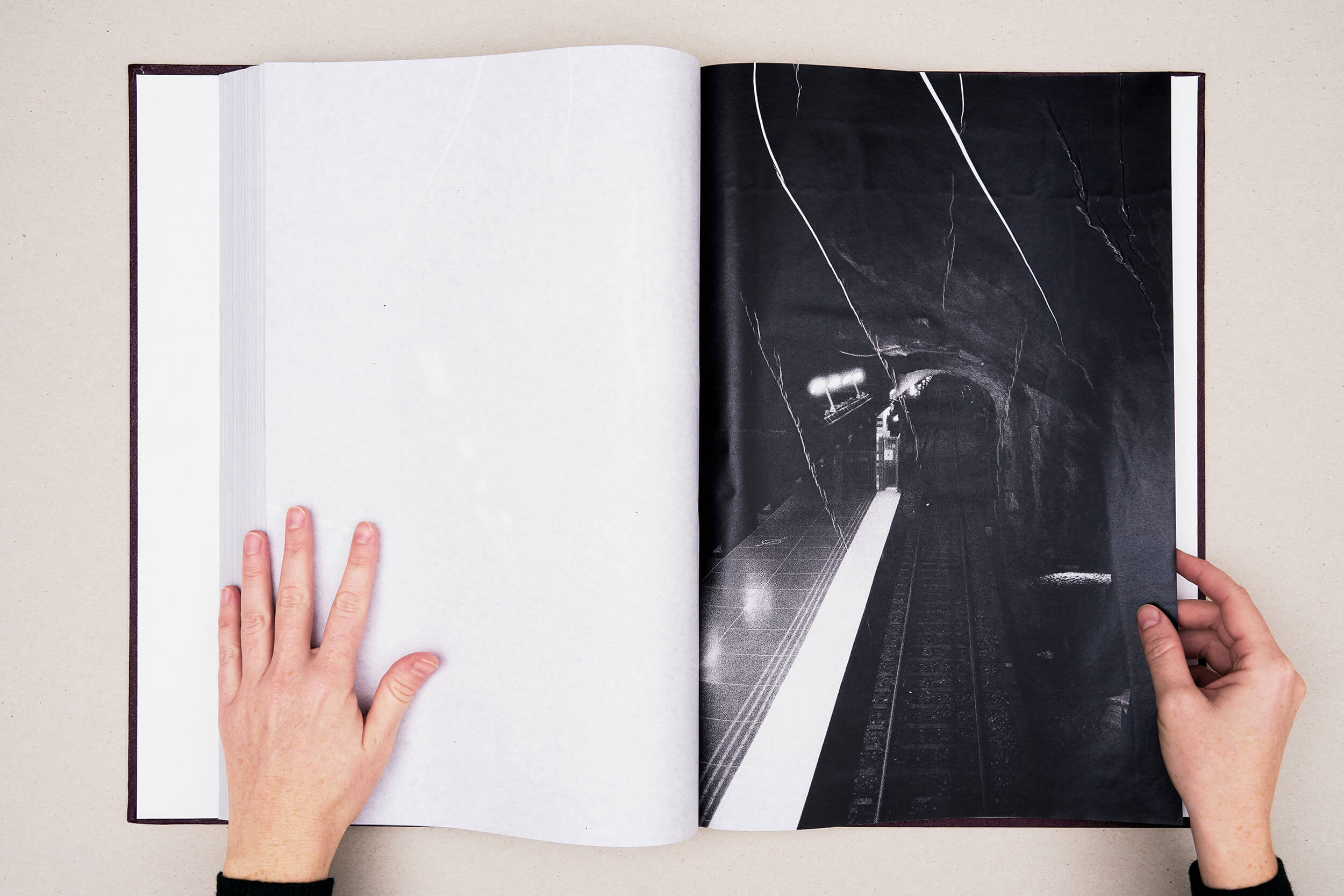





In 2012 Cyprien Gaillard went on a trip to Sri Lanka and visited the city of Kandy located at the geographical center of the country. Kandy is also where the artist printed a few copies of an artist book: “NIGHTLIFE”. Three Star Books in 2019 is publishing it in a revised and augmented three volume version.
2012 “NIGHTLIFE” is the compilation of more than 180 large black and white analog night photos of mostly plants from around the world arranged by the artist in a cinematic sequence.
As Gaillard was wandering through the streets of Kandy, the artist noticed the delicate quality of the paper used for the posters that saturate the city walls. Most street posters in Sri Lanka are printed on a thin 50 grams paper (coated on one side and offset on the other).
After tearing a fragment of a poster off a wall as a paper sample, Cyprien Gaillard entered the first print shop he found and asked if they could make him a large book of his night photos (a project the artist had initiated a few years earlier) and bind the volume according to their local standards.
The Kandy print shop used a laser copy printer but as the thin paper and the copy machine were not compatible, a problem quickly occurred: as the poster paper went through the printing rolls, an irregular white crack randomly appeared along the pages creating a kind of lightning strike across the black and white saturated night images.
The combination of the intense black and white photos, the use of thin poster paper, the waxy effect from the laser printing on the coated paper surface, the white random fractures on the pages, and ultimately the cracking sound created by the bound sheets as the pages were turned produced an effect that seduced Gaillard immediately.
On the original cover, which was designed together with the printer, Gaillard mentioned a press name he had created for that occasion in order to give “NIGHTLIFE” a provenance: the “ROYAL BOTANICAL GARDENS PRESS - PERADENIYA SRI LANKA”.
The few copies of the original “NIGHTLIFE”, were distributed by the artist among his friends and seven years later, Three Star Books is happy to propose a new and augmented version.
2019 “NIGHTLIFE”:
When Cyprien Gaillard came to visit Three Star Books in Paris in 2019, we concluded that the only way to get the same feel and aspect as the original book was to print 2019 “NIGHTLIFE” again in Sri Lanka.
As the artist did not recall where he printed the original book and in order to keep a low carbon trace, we decided to locate printers in Kandy using Google maps and street view.
After a few days of unfruitful searches and a lack of answers from local Kandy printers, one company finally answered us using WhatsApp; text messages became our communication medium. We had to explain to the new printer our desire to print in Sri Lanka in order to keep the original book quality, get the printer to locate the paper we were looking for, the type of printing and binding etc...
Communication was not easy at first but when common trust became reciprocal between our Paris studio and the printer’s shop in Kandy, the production of our first dummy book started.
Cyprien Gaillard (b. 1980) lives and works in Berlin and New York.
***
Notes on NIGHTLIFE by CYPRIEN GAILLARD by Emanuele Coccia
2019
We have no idea what night is. Our culture and our way of life seem to have been built on the opposition between day and night and on the privilege of day and light. Since at least two centuries the night has disappeared, colonised by the life of the day. Since at least two centuries, light has been omnipresent in the interior of apartments and houses: candles, lamps, electricity, nuclear reactors have poisoned the body of the night through the colours of the day. Since at least two centuries, working time has no stop and there is no space when the eyes of all men close simultaneously: the buzzing has been uninterrupted and the sounds of the day continue with the same intensity even after sunset. We have no idea what night is and we will never know, until we’ll stop projecting ourselves into it with the body of the day, persist in inhabiting it and exploring it with the same organs, the same senses, the same ideas that make our daily life possible. To see the night, it is necessary perhaps, to transform our body, or to create new organs of perception: we should become the night, acquire it's same substance and texture, accept that we can not enter the night without changing our form and our nature.
Cyprien Gaillard's book is the account of the metamorphosis that the author had to undergo to see the night. The result of this exploration is something disconcerting. It is not a cartography or a map: it would be like translating the night into daytime forms. It's something much closer to a holy book. If the ancient sacred texts asked themselves "how much of the night still remains" to announce the dawn of revelation, in this sacred text Gaillard announce that we do not need light anymore. Instead of trying to escape the obscurity, or to waiting for the dawn, in the morning, for a liberator of the twilight, he invites us to become the night of the world.
Night is not absence of light. Night is not darkness. Night is an affirmation of a community of substance and appearance between oneself and the surrounding world. The day is the affirmation of a plurality of forms, colours, figures and distances that divide the world and the earth into a multiplicity of substances and individuals. The night dissolves all differences as pious illusions, and lets an identity of appearance and substance appear between all things: not only does the earth have the same colour and the same celestial matter as the rest of the cosmos, but everything, on earth, participates in the same nature. The day is a space of distinction and distance, the night is a space of immersion: to know means to immerse oneself in the known object. To know something no longer means to recognise diversity and distance, but to extend one's body towards infinity - or rather to discover that the other already begins in one's own body. Gaillard’s book bears witness to this discovery. In the night we are all we see. A tree and it's moving branches, the detail of a sidewalk, a cloud of the sky are forms of our body.
That’s the reason why its privileged object are trees. It could sound paradoxical. But it is during the night that we can grasps the real nature of plants and trees. Of course, plants live out of the sunlight which is their unique source of energy. But they perceive light in a different way than ours. Sunlight for them is not something visual. They have no eyes to translate it into colours and forms. They have organs that build out of it their own body: they catch light, they suck it. Light is for them is an infinite stream of particle of force -it is an obscure and dark sea of energy. The sun doesn’t transform the world in a visible and coloured spectacle. It makes out of the planet a sort of nocturnal field crossed by waves of what is their own nourishment. Light is their future body, their future blood.
Night allows us to experience the world in the same way. It allows us, at least for a few hours, to relate to the world as trees do.The limit between the self and the world is the threshold through which each of the two falls and plunges into the other. Night is the space in which knowledge is penetration and confusion, the affirmation of a single substance and a single appearance for all that exists and will exist. Night is the life in which nothing can be extraneous, from moths to stones, from wind to ideas. Everything is in us, and within us. Closing our eyes, we come to coincide with anything else. Opening the book you will discover your own identity.
Three Star Books extends its gratitude to Valentin Bousquet and Louis Gherardi for their skilled and dedicated assistance in the production of NIGHTLIFE.
2012 “NIGHTLIFE” is the compilation of more than 180 large black and white analog night photos of mostly plants from around the world arranged by the artist in a cinematic sequence.
As Gaillard was wandering through the streets of Kandy, the artist noticed the delicate quality of the paper used for the posters that saturate the city walls. Most street posters in Sri Lanka are printed on a thin 50 grams paper (coated on one side and offset on the other).
After tearing a fragment of a poster off a wall as a paper sample, Cyprien Gaillard entered the first print shop he found and asked if they could make him a large book of his night photos (a project the artist had initiated a few years earlier) and bind the volume according to their local standards.
The Kandy print shop used a laser copy printer but as the thin paper and the copy machine were not compatible, a problem quickly occurred: as the poster paper went through the printing rolls, an irregular white crack randomly appeared along the pages creating a kind of lightning strike across the black and white saturated night images.
The combination of the intense black and white photos, the use of thin poster paper, the waxy effect from the laser printing on the coated paper surface, the white random fractures on the pages, and ultimately the cracking sound created by the bound sheets as the pages were turned produced an effect that seduced Gaillard immediately.
On the original cover, which was designed together with the printer, Gaillard mentioned a press name he had created for that occasion in order to give “NIGHTLIFE” a provenance: the “ROYAL BOTANICAL GARDENS PRESS - PERADENIYA SRI LANKA”.
The few copies of the original “NIGHTLIFE”, were distributed by the artist among his friends and seven years later, Three Star Books is happy to propose a new and augmented version.
2019 “NIGHTLIFE”:
When Cyprien Gaillard came to visit Three Star Books in Paris in 2019, we concluded that the only way to get the same feel and aspect as the original book was to print 2019 “NIGHTLIFE” again in Sri Lanka.
As the artist did not recall where he printed the original book and in order to keep a low carbon trace, we decided to locate printers in Kandy using Google maps and street view.
After a few days of unfruitful searches and a lack of answers from local Kandy printers, one company finally answered us using WhatsApp; text messages became our communication medium. We had to explain to the new printer our desire to print in Sri Lanka in order to keep the original book quality, get the printer to locate the paper we were looking for, the type of printing and binding etc...
Communication was not easy at first but when common trust became reciprocal between our Paris studio and the printer’s shop in Kandy, the production of our first dummy book started.
Cyprien Gaillard (b. 1980) lives and works in Berlin and New York.
***
Notes on NIGHTLIFE by CYPRIEN GAILLARD by Emanuele Coccia
2019
We have no idea what night is. Our culture and our way of life seem to have been built on the opposition between day and night and on the privilege of day and light. Since at least two centuries the night has disappeared, colonised by the life of the day. Since at least two centuries, light has been omnipresent in the interior of apartments and houses: candles, lamps, electricity, nuclear reactors have poisoned the body of the night through the colours of the day. Since at least two centuries, working time has no stop and there is no space when the eyes of all men close simultaneously: the buzzing has been uninterrupted and the sounds of the day continue with the same intensity even after sunset. We have no idea what night is and we will never know, until we’ll stop projecting ourselves into it with the body of the day, persist in inhabiting it and exploring it with the same organs, the same senses, the same ideas that make our daily life possible. To see the night, it is necessary perhaps, to transform our body, or to create new organs of perception: we should become the night, acquire it's same substance and texture, accept that we can not enter the night without changing our form and our nature.
Cyprien Gaillard's book is the account of the metamorphosis that the author had to undergo to see the night. The result of this exploration is something disconcerting. It is not a cartography or a map: it would be like translating the night into daytime forms. It's something much closer to a holy book. If the ancient sacred texts asked themselves "how much of the night still remains" to announce the dawn of revelation, in this sacred text Gaillard announce that we do not need light anymore. Instead of trying to escape the obscurity, or to waiting for the dawn, in the morning, for a liberator of the twilight, he invites us to become the night of the world.
Night is not absence of light. Night is not darkness. Night is an affirmation of a community of substance and appearance between oneself and the surrounding world. The day is the affirmation of a plurality of forms, colours, figures and distances that divide the world and the earth into a multiplicity of substances and individuals. The night dissolves all differences as pious illusions, and lets an identity of appearance and substance appear between all things: not only does the earth have the same colour and the same celestial matter as the rest of the cosmos, but everything, on earth, participates in the same nature. The day is a space of distinction and distance, the night is a space of immersion: to know means to immerse oneself in the known object. To know something no longer means to recognise diversity and distance, but to extend one's body towards infinity - or rather to discover that the other already begins in one's own body. Gaillard’s book bears witness to this discovery. In the night we are all we see. A tree and it's moving branches, the detail of a sidewalk, a cloud of the sky are forms of our body.
That’s the reason why its privileged object are trees. It could sound paradoxical. But it is during the night that we can grasps the real nature of plants and trees. Of course, plants live out of the sunlight which is their unique source of energy. But they perceive light in a different way than ours. Sunlight for them is not something visual. They have no eyes to translate it into colours and forms. They have organs that build out of it their own body: they catch light, they suck it. Light is for them is an infinite stream of particle of force -it is an obscure and dark sea of energy. The sun doesn’t transform the world in a visible and coloured spectacle. It makes out of the planet a sort of nocturnal field crossed by waves of what is their own nourishment. Light is their future body, their future blood.
Night allows us to experience the world in the same way. It allows us, at least for a few hours, to relate to the world as trees do.The limit between the self and the world is the threshold through which each of the two falls and plunges into the other. Night is the space in which knowledge is penetration and confusion, the affirmation of a single substance and a single appearance for all that exists and will exist. Night is the life in which nothing can be extraneous, from moths to stones, from wind to ideas. Everything is in us, and within us. Closing our eyes, we come to coincide with anything else. Opening the book you will discover your own identity.
Three Star Books extends its gratitude to Valentin Bousquet and Louis Gherardi for their skilled and dedicated assistance in the production of NIGHTLIFE.


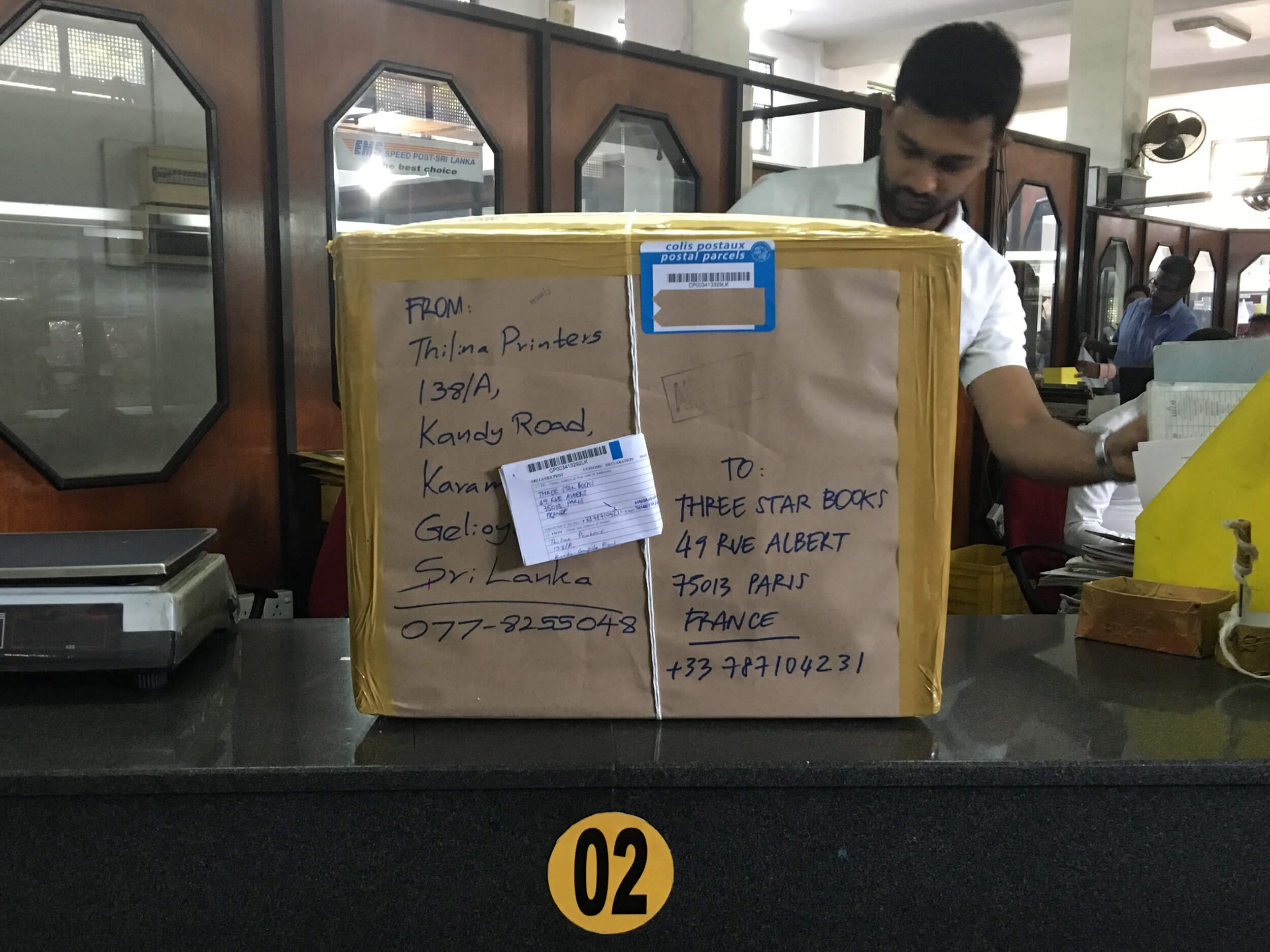







Following the production of “NIGHTLIFE” in Kandy, Sri Lanka